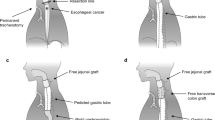Abstract
Background
Thoracoscopic mobilization of the esophagus for pharyngolaryngoesophagectomy allows dissection under direct vision, and therefore it potentially results in fewer complications than conventional transhiatal mobilization. In this article we report our experience with this approach. It was also hypothesized that a learning curve existed and that results have improved over time.
Patients and methods
From July 1994 until January 2004, 57 patients underwent pharyngolaryngoesophagectomy in our institution. Intraoperative events and postoperative outcome were prospectively documented, and long-term follow-up data were also studied. Results were compared between the first 30 patients and the last 27 patients.
Results
There were no significant differences between the two groups with respect to the various clinicopathological characteristics. There was no difference in the median thoracoscopic time between the first 30 and last 27 patients at 90 and 75 min, respectively, p = 0.18. For the complete procedure there was significantly less blood loss in the later group; median (range) blood loss 700 (164–3000) ml versus 400 (100–1200) ml, p = 0.002. Overall pulmonary complications occurred in 12 patients (40%) in the first group versus 13 (48%) in the second group, p = 0.6. The incidence of atrial arrhythmia was also similar, affecting 6 (20%) patients and 3 (11%), respectively, p = 0.47. Hospital mortality rates were 13.3% and 7.4%, p = 0.67. Two-year survival rates were no different (46% versus 45% p = 0.85).
Conclusions
Although, subjectively, operating skills have improved over time, better results in the second half of this series could not be demonstrated clearly, likely because the operating surgeons had prior extensive experience in esophageal and thoracoscopic procedures.
Similar content being viewed by others
References
Hulscher JB, van Sandick JW, de Boer AG, Wijnhoven BP, Tijssen JG, Fockens P, Stalmeier PF, ten Kate FJ, van Dekken H, Obertop H, Tilanus HW, van Lanschot JJ (2002) Extended transthoracic resection compared with limited transhiatal resection for adenocarcinoma of the esophagus. N Engl J Med 347:1662–1669
Lau H, Law S, Wong J (1997) Prospective evaluation of vacuum pleural drainage after thoracotomy in patients with esophageal carcinoma. Arch Surg 132:749–752
Law S, Boey JP, Kwok KF, Wong KH, Chu KM, Wong J (2004) Pleural drainage after transthoracic esophagectomy: experience with a vacuum system. Dis Esophagus 17:81–86
Law S, Fok M, Chu KM, Wong J (1997) Thoracoscopic esophagectomy for esophageal cancer. Surgery 122:8–14
Law S, Wong KH, Kwok KF, Chu KM, Wong J (2004) Predictive factors for postoperative pulmonary complications and mortality after esophagectomy for cancer. Ann Surg 240:791–800
Law SY, Fok M, Wei WI, Lam LK, Tung PH, Chu KM, Wong J (2000) Thoracoscopic esophageal mobilization for pharyngolaryngoesophagectomy. Ann Thorac Surg 70:418–422
Metzger R, Bollschweiler E, Vallbohmer D, Maish M, DeMeester TR, Holscher AH (2004) High volume centers for esophagectomy: what is the number needed to achieve low postoperative mortality? Dis Esophagus 17:310–314
Miller JD, Jain MK, de Gara CJ, Morgan D, Urschel JD (1997) Effect of surgical experience on results of esophagectomy for esophageal carcinoma. J Surg Oncol 65:20–21
Ong GB, Lee Y (1960) Pharyngogastric anastomosis after oesophago-pharyngectomy for carcinoma of the hypopharynx and cervical oesophagus. Br J Surg 48:193–200
Osugi H, Takemura M, Higashino M, Takada N, Lee S, Kinoshita H (2003) A comparison of video-assisted thoracoscopic oesophagectomy and radical lymph node dissection for squamous cell cancer of the oesophagus with open operation. Br J Surg 90:108–113
Osugi H, Takemura M, Higashino M, Takada N, Lee S, Ueno M, Tanaka Y, Fukuhara K, Hashimoto Y, Fujiwara Y, Kinoshita H (2003) Learning curve of video-assisted thoracoscopic esophagectomy and extensive lymphadenectomy for squamous cell cancer of the thoracic esophagus and results. Surg Endosc 17:515–519
Robertson GSM, Lloyd DM, Wicks A, Veitch PS (1996) No obvious advantages for thoracoscopic two-stage esophagectomy. Br J Surg 83:675–678
Shikora SA, Kim JJ, Tarnoff ME, Raskin E, Shore R (2005) Laparoscopic Roux-en-Y gastric bypass: results and learning curve of a high-volume academic program. Arch Surg 140:362–367
Sutton DN, Wayman J, Griffin SM (1998) Learning curve for oesophageal cancer surgery. Br J Surg 85:1399–1402
Swisher SG, Deford L, Merriman KW, Walsh GL, Smythe R, Vaporicyan A, Ajani JA, Brown T, Komaki R, Roth JA, Putnam JB (2000) Effect of operative volume on morbidity, mortality, and hospital use after esophagectomy for cancer. J Thorac Cardiovasc Surg 119:1126–1132
Tsui SL, Law S, Fok M, Lo JR, Ho E, Yang J, Wong J (1997) Postoperative analgesia reduces mortality and morbidity after esophagectomy. Am J Surg 173:472–478
van Lanschot JJ, Hulscher JB, Buskens CJ, Tilanus HW, ten Kate FJ, Obertop H (2001) Hospital volume and hospital mortality for esophagectomy. Cancer 91:1574–1578
Watson A, Allen PR (1994) Influence of thoracic epidural analgesia on outcome after resection for esophageal cancer. Surgery 115:429–432
Wei WI, Lam LK, Yuen PW, Wong J (1998) Current status of pharyngolaryngo-esophagectomy and pharyngogastric anastomosis. Head Neck 20:240–244
Wong SK, Chan AC, Lee DW, To EW, Ng EK, Chung SC (2003) Minimal invasive approach of gastric and esophageal mobilization in total pharyngoesophagectomy. Total laparoscopic and hand-assisted laparoscopic technique. Surg Endosc 17:798–802
Acknowledgments
H. A. Cense was supported by grants from the Dutch Cancer Society and The Trust Fund of the Erasmus University of Rotterdam, The Netherlands.
Author information
Authors and Affiliations
Corresponding author
Rights and permissions
About this article
Cite this article
Cense, H.A., Law, S., Wei, W. et al. Pharyngolaryngoesophagectomy using the thoracoscopic approach. Surg Endosc 21, 879–884 (2007). https://doi.org/10.1007/s00464-006-9049-z
Received:
Revised:
Accepted:
Published:
Issue Date:
DOI: https://doi.org/10.1007/s00464-006-9049-z




